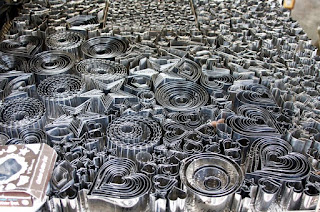 We visited Kyushu, the big southern island of Japan, for the first time.
Over three days we hired a car and wandered around a most beautiful
place. Parts of it are very green and wild and it has a different
feel to the rest of Japan, more like SE Asia in some ways.
We visited Kyushu, the big southern island of Japan, for the first time.
Over three days we hired a car and wandered around a most beautiful
place. Parts of it are very green and wild and it has a different
feel to the rest of Japan, more like SE Asia in some ways.One of the great specialties of the region is pottery. There are many famous kilns in the towns of Arita and Karasu and indeed dotted in towns and villages all over the place.
 Here a 400 year sloping kiln used by the one family business until recently when they built this one:
Here a 400 year sloping kiln used by the one family business until recently when they built this one:
And the marvellous stacks of wood ready for use neatly tied with bamboo.

Pottery is for sale everywhere and I have to admit to being a bit of a dunce where it is concerned. "I don't know much about pottery but I know what I like."
For instance you will see something very beautiful and it will cost perhaps $30 and then you will see this tea bowl:
A steal at $12,600.

Like Murano in Venice with its glass, many of the towns were totally closed to the outside world to protect their secrets. There were customs gates and no-one was allowed to enter or leave. This town is located in a blind valley deep in the mountains.
They are very good with clay: here a road gutter outside a house. We saw this sort of design using old roof tiles etc, many times.

The roof beams of one of the buildings.
 We went to a marvellous tofu shop with a little restaurant attached. Peaceful, simple, and everything made from tofu and soy milk.
We went to a marvellous tofu shop with a little restaurant attached. Peaceful, simple, and everything made from tofu and soy milk.On the walls there was a simply painted bird on a twig design , the ink even running over the woodwork.
For dessert amazingly large white strawberries, only available in this town.


In a another soba noodle restaurant some wheat stalks embedded in the walls, such an effective decoration
Steam rising from the hotsprings.

 A temple where students come from all over Japan and many other countries come to pray for good exam results and leave hopeful messages to the gods. Long ago a teacher was exiled to this region. When he died the authorities in Kyoto felt they were being haunted by his soul so a magnificent temple was built to calm the spirit. One of the features are trees that are now more than a thousand years old.
A temple where students come from all over Japan and many other countries come to pray for good exam results and leave hopeful messages to the gods. Long ago a teacher was exiled to this region. When he died the authorities in Kyoto felt they were being haunted by his soul so a magnificent temple was built to calm the spirit. One of the features are trees that are now more than a thousand years old.
Fukuoka is a pleasant and lively city, not as mad a Tokyo. A long-time trading gateway to the rest of Asia it somehow has a more Asian feel to it compared to other parts of Japan. One of the features are the Yatai, mobile street carts that are set up at night and serve a fantastic range of food and drink. Much like you see in SE Asia. In the morning all is quiet and clean and the little restaurants have disappeared

There were dozens of them doing a thriving business along the river across from our hotel.

A local specialty, Mochi Mochi gyoza.










































